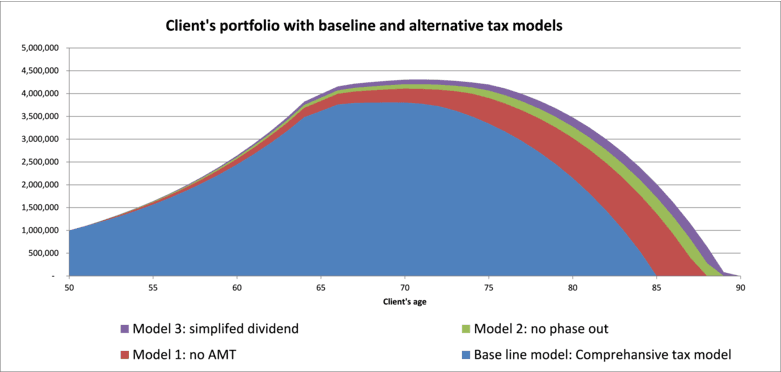
There is no denying that our U.S. tax system has become mind-numbingly complex, but it is equally true that tax expenses can represent a significant portion of many clients’ overall expenses in their retirement plan. While it is impractical to incorporate all the tax details in your clients’ retirement plans, it is absolutely critical to be able to reasonably account for tax expenses in the retirement plans you prepare.
Simply too simple?
An analysis performed by RightCapital illustrates the large risk of oversimplifying the tax expense component in retirement planning. For the hypothetical client we analyzed, a simplified tax expense model revealed a tax expense “miss” that amounted to five years worth of the client’s retirement expenses! The key take-away for advisors is that now is a good time to thoroughly review the approaches you use to calculate tax expense in retirement planning and understand the potential impact of any tax simplification to the retirement plan.
Methodology
To understand the potential impact of using over simplified tax modeling, we compared the retirement plan results using different tax modeling approaches. We first created a baseline retirement plan with a very detailed and rigorous tax model. Then, we created multiple alternative retirement plans with simplified tax modeling, removing some of the tax components from the baseline model. We compared the retirement planning results between our baseline financial planning model and the alternative financial planning models. The comparison clearly illustrates the impact of using simplified tax projections for retirement planning.
Analysis results
We ran our projection model with the comprehensive tax model and the results showed that the hypothetical client will run out of money at age 85. The table below shows the age that the client runs out of money under each of the simplified tax models. An advisor who used a tax simplification approach like Model 3 to do the financial plan for this hypothetical client, would miss the age the client would run out of money by five years!


Conclusion
The analysis indicates that the tax expense simplification approach you use in preparing financial plans can have a significant impact on the robustness of your clients’ retirement plans. Using a simplified tax expense approach risks materially underestimating the real impact of tax expenses. The bottom line: prudent tax modeling in retirement planning matters -- a lot!
Appendix 1: Tax modules in the baseline financial planning model
The baseline financial planning model includes very detailed tax projection capability. Some of the key components are included in the baseline model:
A very detailed 1040; Personal Exemption Reduction Worksheet, Taxable Social Security worksheet; Student Loan Interest Deduction Worksheet;
Schedule A
Schedule B
Schedule D, 28% Rate Gain Worksheet; Unrecaptured Section 1250 Gain Worksheet; Capital Loss Carryover worksheet; Qualified Dividends and Capital Gain Tax Worksheet
Schedule E; Passive Activity Loss Limitations (Form 8582); 1250 Worksheet; At-Risk Limitation (form 6198); Sale of Business Property (Form 4797)
Alternative minimum tax and (Form 6251) and Exemption Worksheet
Net Investment Income Tax (Form 8960)
FICA, Schedule SE
Annual tax inflation on all tax related values such as brackets, exemptions, etc. per Federal guidelines
Appendix 2: Data used for the hypothetical household
The hypothetical household we created include a couple aged 50 and 48. Some key assumptions used include the following: annual income of $375,000, monthly expense of $17,000 and retirement expense of $15,000. The household has total of $1,000,000 invested assets, half in tax deferred accounts and half in taxable accounts. The household also has a $300,000 mortgage balance on a $800,000 house. The hypothetical clients have target retirement at age 65. We also included estimated Social Security benefits starting at age 65. We assumed an initial equity and fixed income asset allocation of 70/30 and a flat return of 7.5%. We also made various assumptions including initial cost basis for investment, the percentage split of qualified dividends and ordinary dividends, percentage split of long term capital gains and short term capital gains.